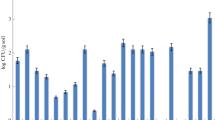Abstract
Distribution and activity of microorganisms in surface soil and subsurface sediments were studied in depth profiles of six different microbial biomass and activity indicators (total direct counts, number of cells capable of electron transport system activity, viable cell plate counts, most Probable numbers of protozoa, and 4-hydroxybenzoate-degrading microorganisms, and ATP content). The profiles showed the same general trends on two different dates (January and June 1985). Seasonal variations were noted, but they were not extreme. Biomass and activity values declined sharply with depth in the unsaturated zone, reaching minima in a clay confining layer in the interface zone between 3 and 4 m. Contiguous 10-cm samples from the interface zone showed significant textural and microbiological variability. Higher and more stable biomass and activity values were detected in the saturated zone, the highest being a very permeable gravelly loamy sand layer at approximately 7.5 m. In this layer, viable counts were nearly equal to total counts and they approached the viable counts in surface soil. Surface-type protozoa and cyanobacteria also were detected in this layer, suggesting that it was connected hydrologically to a nearby river. Lowest values were detected in an underlying bedrock clay layer at 8 m, which, despite its impermeability and low viable counts, did contain measurable total counts, 4-hydroxybenzoate-degrading microorganisms, and ATP. Correlations were noted between sediment texture and microbial activity (i.e., sandy texture=high activity, clayey texture=low activity), but other hydrogeological and geochemical factors probably also influenced microbial distribution and activity in the profile.
Similar content being viewed by others
References
Balkwill DL, Ghiorse WC (1985) Characterization of subsurface bacteria associated with two shallow aquifers in Oklahoma. Appl Environ Microbiol 50:580–588
Bone TL, Balkwill DL (1986) Improved flotation technique for microscopy of in situ soil and sediment microorganisms. Appl Environ Microbiol 41:462–468
Bone TL, Balkwill DL (1988) Morphological and cultural comparison of microorganisms in surface soil and subsurface sediments at a pristine study site in Oklahoma. Microb Ecol 16: 49–64
Conn HJ (1918) The microscopic study of bacteria and fungi in soil. New York State Agric Expt Sta Tech Bull 64:3–20
Foss JE, Wright WR, Coles RH (1975) Testing the accuracy of field textures. Soil Sci Soc Am Proc 39:800–802
Freeze RA, Cherry JA (1979) Groundwater. Prentice Hall, Englewood Cliffs, New Jersey
Ghiorse WC, Balkwill DL (1983) Enumeration and morphological characterization of a bacteria indigenous to subsurface environments. Dev Ind Microbiol 24:213–224
Ghiorse WC, Balkwill DL (1985) Microbiological characterization of subsurface environments. In: Ward CH, Gieger W, McCarty PL (ed) Ground water quality. John Wiley and Sons, New York, pp 536–556
Gottfreund E, Gottfreund J, Gerber I, Schmitt G, Schweisfurth R (1985) Occurrence and activities of bacteria in the unsaturated and saturated underground in relation to the removal of iron and manganese. Water Supply 3:109–115
Harvey RW, Smith RL, George L (1984) Effect of organic contamination upon microbial distributions and heterotrophic uptake in a Cape Cod, Mass, aquifer. Appl Environ Microbiol 48:1197–1202
Hirsch P, Rades-Rohkohl E (1983) Microbial diversity in a groundwater aquifer in northern Germany. Dev Ind Microbiol 24:183–200
Hoos E, Schweisfurth R (1982) Untersuchungen über die Verteilung von Bakterien von 10 bis 90 m unter Bodenoberkante. Vom Wasser 58:103–122
Karl DM (1986) Determination of in situ microbial biomass, viability, metabolism, and growth. In: Poindexter JS, Leadbetter ER (eds) Bacteria in nature, vol. 2. Methods and special applications in bacterial ecology. Plenum Press, New York, pp 85–176
Marxen J (1981) Bacterial biomass and bacterial uptake of glucose in polluted and unpolluted groundwater of sandy and gravelly deposits. Verh Internat Verein Limnol 21:1371–1375
Matthess G (Harvey JC, Transl.) (1982) The properties of groundwater. John Wiley and Sons, New York.
Newell SY, Fallon RD, Tabor PS (1986) Direct microscopy of natural assemblages. In: Poindexter JS, Leadbetter ER (eds) Bacteria in nature, vol. 2. Methods and special applications in bacterial ecology. Plenum Press, New York, pp 1–48
Owens JD, Keddie RM (1969) The nitrogen nutrition of soil and herbage coryneform bacteria. J Appl Bacteriol 32:338–347
Russek E, Collwell RR (1983) Computation of most probable numbers. Appl Environ Microbiol 45:1646–1650
Sinclair JL, Ghiorse WC (1987) Distribution of protozoa in subsurface sediments of a pristine groundwater study site in Oklahoma. Appl Environ Microbiol 53:1157–1163
Singh BN (1955) Culturing soil protozoa and estimating their numbers in soil. In: Kevan DKMcE (ed) Soil zoology. Butterworths, London, pp 403–411
Soil Survey Staff (1951) Soil Survey Manual. USDA Handbook No. 18, U.S. Government Printing Office, Washington, DC
Thomas LC, Chamberlin GJ (1980) Colorimetric chemical analytical methods, 9th ed. John Wiley and Sons, New York
Towler PA, Blakey NC, Irving TE, Clark L, Maris P, Baxter KM, MacDonald RM (1985) A study of the bacteria of the chalk aquifer and the effect of landfill contamination at a site in eastern England. Hydrogeology in the service of man, vol. 18, Part 3. Groundwater quality management. Memoirs of the 18th Congress Intl Assoc Hydrogeol, Cambridge 1985 (IAHS Publ. No. 154), pp 84–97
Trolldenier G (1973) The use of fluorescence microscopy for counting soil microorganisms. In: Rosswall T (ed) Modern methods in the study of microbial ecology. Bulletins from the Ecological Research Committee, Swedish Natural Sciences Research Council (Stockholm) 17: 53–59
Webster JJ, Hampton GJ, Wilson JT, Ghiorse WC, Leach FR (1985) Determination of microbial cell numbers in subsurface samples. Ground Water 23:17–25
White DC, Fredrickson HF, Gehron MJ, Smith GA, Martz RF (1983) The ground water aquifer microbiota: biomass, community structure, and nutritional status. Dev Ind Microbiol 24:189–199
Wilson JT, McNabb JF, Balkwill DL, Ghiorse WC (1983) Enumeration and characterization of bacteria indigenous to a shallow water-table aquifer. Ground Water 21:134–142
Wilson JT, Miller GD, Ghiorse WC, Leach RF (1986) Relationship between the ATP content of subsurface material and the rate of biodegradation of alkylbenzenes and chlorobenzene. J Contain Hydrol 1:163–170
Author information
Authors and Affiliations
Rights and permissions
About this article
Cite this article
Beloin, R.M., Sinclair, J.L. & Ghiorse, W.C. Distribution and activity of microorganisms in subsurface sediments of a pristine study site in Oklahoma. Microb Ecol 16, 85–97 (1988). https://doi.org/10.1007/BF02097407
Issue Date:
DOI: https://doi.org/10.1007/BF02097407




